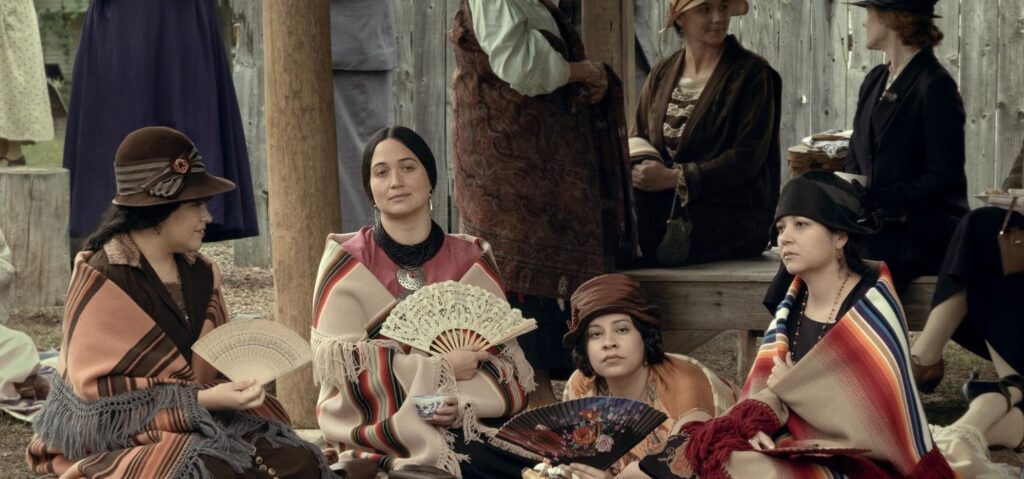
This movie left many viewers in awe. After it was premiered, Google searches for Osage went up 75% and most frequently asked question was whether Killers of Flower Moon is true? This reaction always comes out when history stories become public knowledge through films. Its story with all its evidence has been in The National Archives for ages. Here’s how that tragedy came to light.
Killers of the Flower Moon History of Osage Nation
The tribe known as the Osage has a long history in this country first appearing in about 700 B.C. The name “Osage” means “People of the Middle Waters,” which refers to their place of origin, near the Ohio and Mississippi Rivers. Hundreds of years later, they would still live close to water after migrating westward to where Missouri River meets Mississippi River.
It is here where they settled on their ancestral lands and maintained considerable influence throughout much of the Midwest. Both indigenous and colonial populations reacted with a mixture of fear, awe and respect each time these people were mentioned due to their fearsome reputation and multi-dimensional skills. Their trading posts were instrumental to economic development across the West; hence relationships between them existed alongside French fur-traders.
However, things changed very quickly for the Osage after Louisiana Purchase. Early into American acquisition of land, famous explorer Meriwether Lewis warned President Thomas Jefferson that powerful Osages could be problematical. Eastern United States population was growing while pioneers wanted access to “unoccupied” territories. Since confronting U.S government directly was not possible due to their mightiness among others tribes though quietly but deliberately prompted other tribes into fighting them. Them east Indian nations pushed off their lands by US government became invaders from Native American perspective rather; not displaced nations as seen by Osages during western expansion where land parcels kept reducing each day.
The 19th century was brutal for the Osages. In the 1830s, missionaries and settlers came into contact with the tribe — bringing smallpox with them. It was a catastrophe of enormous proportions. By Civil War times though, the Osage were living in what is now Kansas, but that soon-to-be state was embroiled in its own war over whether it would come into the Union as a free or slave state. Although trying to remain neutral as Civil War boiled over, geography did not favor them. They found themselves surrounded by Union and Confederate forces as both sides ransacked Osage Nation to feed their soldiers. Consequently, there was terrible famine among them due to which by 1870s they had lost half of their numbers.
By the end of the Civil War, Osages sought to leave behind their troubled lands in Kansas. They sold it to Grant administration and bought a reservation of their own in Indian Territory (now Oklahoma), an unusual act for native American tribes at that time. Ownership did not matter to them anymore since they were impoverished and plagued by sicknesses for years on end apart from fighting wars and displacement until gold came along.
Killers of the Flower Moon Osage Riches
In 1894, there was the discovery of oil under the reservation. It was immensely profitable for the Osage to own mineral rights to their land, despite a government-enforced cap restricting them to only 10% of the profit from oil. That meant that they were making between $10-30 million per year at this time and became some of the richest people in the world.
Then on March 3, 1921, Congress created a program called “guardianship” which it said would help the Osage run their money. A guardian was appointed for any person who had more than one-half Indian blood or was an Osage minor until that individual could prove competence sufficient to take charge of his/her own finances. Even how much money an Osage received was controlled by guardians let alone where they spent it and they were paid for their services often directly out of what an Osage made. So, whether or not a member of the tribe is considered competent comes up in Indian census rolls, which means no “incompetent” person shall be given monies without a guardian being present or even permitting them.
The guardianship initiative failed to shield the Osage; instead, it marked them for harm. Settlers came in droves hoping to make money from Oklahoma’s oil, with white businessmen, lawyers and other whites trying hard take over mineral rights from these Indians. But perhaps most dangerous were actions done by white male settlers who married native women in order to claim themselves as husbands and thus become guardians entitled to control wives’ earnings.
Killers of the Flower Moon tells Mollie Burkhart’s story as she took her husband’s name after marriage; he was Ernest Burkhart, a white man. The large family of Mollie owned several pieces on lands within this reservation (Osage) thriving because of revenues coming from minerals too. However, all these changed in 1918 when her sister Minnie died after failing to combat a wasting illness. Her mother also met a similar fate some years subsequent to this event. Mollie’s second sister, Anna, was found dead having a bullet lodged in the back of her head while she lay in a ravine during May 1921. For Rita and Bill (her brother-in-law), they were killed by an explosion that leveled their house during one violent episode among others. Similarly, Henry Roan who was Mollie’s cousin got shot dead almost two years later.
Neither Mollie nor her family were the only victims of what happened: The Osage were experiencing many inexplicable deaths that the local authorities would find it easy to term as accidents, suicides or even alcohol poisoning across the reservation. However, those in Osage knew better than anyone else did. In 1925 they asked for help from J.Edgar Hoover’s Federal Bureau of investigation – which was new at that time – so that it could solve these crimes for them.
Unraveling the Conspiracy

Infiltration came from FBI agents into tribes and settlers alike; and with them began the unraveling of lies and murder uprooting the whole place: William Hale is at its center.
Hale was a local rancher, but also known as the “King of Osage Hills.” Hale was shrewd, focused and cruel and understood how much money he could make from cheating the osage out of their mineral rights. He also fabricated life insurance policies on his wife’s cousin Henry Roan, for $25,000, which named him as the sole heir. Two weeks later Roan died. When his cons failed to produce the kind of money he was looking for, Hale turned to murder. But he did not work alone. One of his accomplices was another native Ramsey John. The other one being his nephew – Ernest Burkhart.
Suddenly all the pieces fitted together in my head.Under Guardianship Program, Ernest had applied for and been given guardianship over Mollie. Once her family members started dying mysteriously their mineral rights were transferred among themselves.Soon she was left alone.
Hale and others involved in the conspiracy were arrested. Hale, Ramsey and Burkhart faced indictments for conspiracy and murder in 1926. At first Ernest pleaded innocent however after two months into trial he changed his mind. With this change came his story: hale masterminded all murders.Upon any death in the family he orchestrated a plan that made sure mineral rights went to her relatives only. Ernest would kill all Mollies family so that she could be killed last to enable him gain maximum profits after inheriting all mineral rights from her late parents’ property.
During Ernest’s trial it emerged that doctors had found poison in Mollie’s bloodstream while efforts were going on to kill her with more poison.She lived through it though.
Finally Hale along with associates were convicted of murdering members of Molly’s family. However during those seven years over sixty people were killed on reservations by Osage who these people called “Reign Of Terror”.Many remain unsolved today.
Bringing the Truth to Light Decades Later
“Killers of the Flower Moon: The Osage Murders and the Birth of the FBI” by David Grann is a book-true story that exposes one of the most sinister crimes in America. But how exactly does one come upon these hidden treasure troves? It began for author David Grann when he visited Pawhuska, Oklahoma’s Osage Nation museum in 2012. One of them had been deliberately removed, though it was quite clear. “The devil was standing right there,” she explained.
It was William Hale who was called the devil. However, Grann didn’t want his book focused on the person who caused so much tragedy. Instead he chose Mollie who is not only the last remaining member of her family, but also dedicated herself to seeking justice tirelessly.“ She longed desperately for justice even at great risk to her own life.” These events would not be comprehensible without her point of view,” According to Grann.
In order to tell Mollie’s story, Grann started his research at National Archives Museum in Fort Worth.The archives staff learned about his fascinating discoveries and offered assistance by supplying him with over three thousand papers relating to Osage which include:
– Raw testimonies from surviving osages
- Private detectives’ files on both the offenders and their accomplices
- Classified grand jury depositions
- Records from J. Edgar Hoover, the FBI director who took on the case that made the Bureau what it is today.
In addition to his research, Grann also conducted interviews with family members of these Osage men and women who lived through it all.
According to Grann: “The Museum Director removed a photograph of a killer not to forget what happened to the Osage; they can’t forget. Nevertheless, like me, too many Americans did not know or simply forgot about history… This is also another reminder that our history exists in archives waiting for us to tell them.”
What this movie projects onto its screen is a striking tale that we find hard to confront, making some people think that such kind of events are just movies written by creative Hollywood writers. Actually, most things depicted in this film are true. The film’s essence including William Hale’s wickedness and exploitation of the Osage as well as local authorities’ nonchalant attitude are extracted directly from museum displays and ancient texts. Our collective past may not always be something we enjoy seeing in a mirror but learning about it and facing it can light up our path going forward